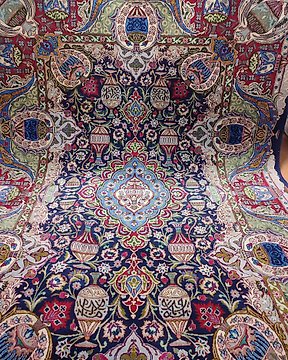
Kashmar lana kurk persan - Covor - 296 cm - 209 cm
Nr. 83286975

Nr. 83286975

Knot density: approx. 200.000 knots/sqm 30 Radj, very fine knotting
Origin: Persia Markazi province
Condition: like new, washed
Pattern: Sarough Farahan Medallion
Material: pile 100% wool on 100% cotton
PERSIAN CARPET SAROUGH & FARAHAN
The ancient Sarouk-Rug has one of the most recognizable names and visual styles of all ancient Persian rugs. Persian sarouk rugs are characterized by their intricate curvy, floral patterns typically found in rugs woven in larger city centers where more sophisticated weavers would work in organized workshops.
Surprisingly, the village of Sarouk is relatively small and located in the province Markazi, which is at the north end of the central-west Persian district Arrack lies.
The village of Sarouk (sometimes spelled Saruq or Saroogh) is much smaller than some of the other major Persian carpet weaving centers such as Tabriz in the northwest, Meshed in the northeast or Kerman in the south.
Village rugs also tend to be more informal in design, with simpler geometric motifs and less elaborate and rudimentary designs than their urban counterparts. So how did it come about that the relatively small village of Sarouk became one of the centers of production of some of the best-known floral city rugs in the rug trade?
THE SURPRISING HISTORY OF THE ANCIENT PERSIAN SAROUK CARPET
The Persian village of Sarouk has long been known as a traditional center of carpet weaving, but not necessarily for producing the type of antique carpets we would recognize as sarouks today. Most likely, the carpets woven in this village before the late 19th century were stylistically closer to the village carpets woven in nearby Ferahan.
By the mid-XNUMXth century, several Western exporters, including such well-known names as Ziegler & Company, carpet weaving mills in the Iran and began mass exporting traditional Persian rugs to wealthy buyers in the European market.
These western exporters were initially based in the northwestern weaving center of Tabriz, but soon expanded their activities
expand to the south. The next major weaving center was established in what we would now call Arak, which was then called Sultanabad.
The village of Sarouk was only thirty miles north of Sultanabad and was much sought after for its accessibility and tradition of carpet weaving.
THE FARAHAN SAROUK CARPET
In the late XNUMXth century, western exporters revolutionized carpet production in Sarouk, setting up well-organized workshops and ordering carpets with sophisticated designs and visual aesthetics for sale to their customers in Europe.
Perhaps the most prominent carpet style that came into its own during this period was the Persian Ferahan Sarouk carpet, which incorporated some stylistic elements from the nearby Ferahan weaving region, some aesthetic elements and weaving elements from the fine carpets woven in Tabriz to the north and adopted some of the masterful skills of the traditional weavers from Sarouk itself - all under the supervision of enterprising western exporters.
Antique Persian Ferahan Sarouk rugs are typically characterized by a tight weave, short pile height, fine, soft wool, a design aesthetic that favors central medallions and intricately articulated floral motifs, and not uncommonly a combination of deep red and dark Blue as the two dominant colors.
THE MOHAJERAN SAROUK CARPET
The popularity of these fine Persian carpets, such as the Ferahan Sarouk and the Hadji Jalili carpet from Tabriz, boomed in Europe and North America, especially after they appeared at the first World's Fairs for oriental carpet were shown in Vienna and London in the late 1800s.
This is how the Mohajeran Sarouk carpet came about. Similar to the popularization of the Ferahan-Sarouk carpet style, which was based on extended versions of native carpet-weaving from the villages of Ferahan and Sarouk, the Mohajeran-Sarouk carpet was the next carpet style to come into vogue for export to the West.
The history of Mohajeran Sarouk is very similar to that of Ferahan Sarouk, as Mohajeran was also a traditional weaving center near the small village of Sarouk. Led by western exporters, it also became an important center for the manufacture of new variants of the old sarouk, which were exported to Europe and eventually America.
The rugs traditionally woven in Mohajeran were thicker in pile and more decentralized in their design aesthetic than their Ferahan counterparts. When these traditional Mohajeran carpets were brought together with the new generation of carpets made in Sarouk under Western supervision, the Mohajeran-Sarouk carpet style was born.
“Errors and mistakes excepted”
Cum să cumperi de la Catawiki
1. Descoperă ceva special
2. Plasează cea mai mare ofertă
3. Fă o plată sigură